How to Form the Future Simple Tense:
(Will / Shall)
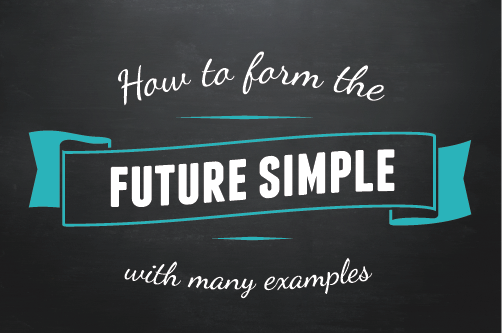
Let's learn how to form the future simple tense with "will" and "shall". We'll learn how to make positive and negative forms, short forms (contractions) and questions.
[Note: Click here to learn how to use "will" and "shall".]
Are you ready? Let's get started!
Future simple with "will"
Forming this tense is.... rather simple. Yay!
- Add "will" after the subject + the infinitive of the verb.
That's it! You use the same form for all subjects (I / you / he / she / it / we / you / they).
Also, it's very common to use contractions in spoken English. Why do we use contractions? This enables us to speak more quickly in English.
I will = I'll, you will = you'll, he will = he'll, she will = she'll, we will = we'll, they will = they'll
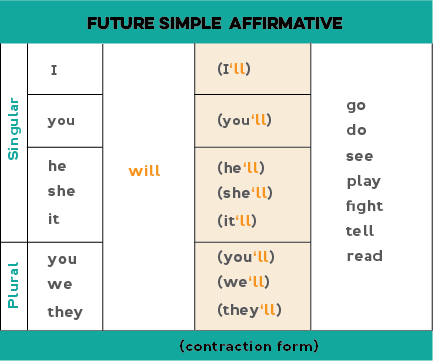
Examples:
- I will go to the store now. / I’ll go to the store now.
- He will do it soon. /He’ll do it soon.
- We’ll see him later.
- Our coach thinks we will play tomorrow at 3 o’clock.
- The boys will fight all day.
- Careful! Your manager will probably read those messages.
Negative form of future simple with "will"
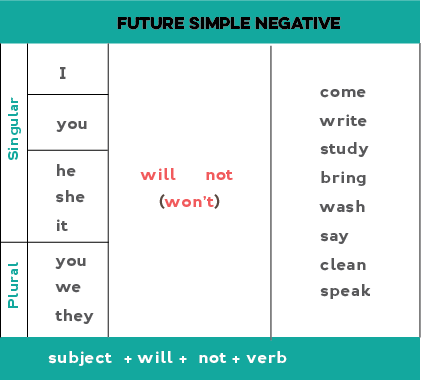
For the negative, we add "will not" (or won't) for all subject forms. Again, very simple!
Examples:
- You girlfriend will not be happy about that.
- Our manager won’t write me a recommendation.
- He won’t study this afternoon.
- I’m sure they won’t bring anything to the party.
- My husband won’t say what’s wrong.
- My children will not clean their rooms.
- I will not speak to him again.
Yes / no questions with "will"
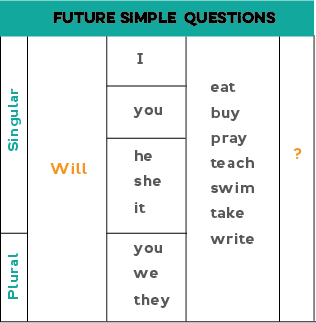
For yes or no questions use: Will + subject + infinitive?
Examples:
- Will we eat soon?
- Will he buy her a gift?
- Will you please pray for me?
- Will they swim in the lake or the pool?
- Will the teacher speak English?
- Will they take credit cards?
- Will I write? Of course, I’ll write every day.
Wh- questions with "will"
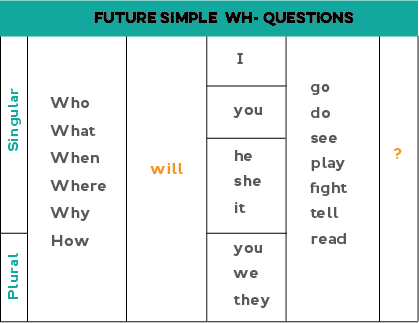
For wh- questions use: Wh- question + will + subject + infinitive?
Examples:
- Now where will he go?
- What will they do?
- Who will you see in New York?
- What time will we play tennis?
- When will the boxers fight again?
- Why will you tell your parents?
- How many times will you read that email?
Future simple with "shall"
We can also use “shall” to create the future simple tense.
However, we typically only use “shall” with the “I” and “we” forms. We rarely use shall with “you,” “he,” “she,” “it,” and “they”. Click here to learn about when use the “shall” form.
The forms for “shall” are:
Affirmative statements: subject + “shall” + infinitive
Negative statements: subject + shall + not + infinitive
Questions: shall + subject + infinitive ?
Wh- questions: Wh- question shall + subject + infinitive ?
Examples:
- I shall be there soon.
- We shall not arrive before noon.
- What shall we do today?
- Shall we take the bus or drive?
- It’s cold. Shall I close the window?
Final Note: "Be going to"
In addition to using "will" and "shall," we can also form the simple future tense using "be going to." To learn more about this, please visit this page.
Click here to learn how to USE the future simple tense.
- Home Page ›
- Main Grammar Page ›
- Use: Future simple ›
- Form: Future simple
